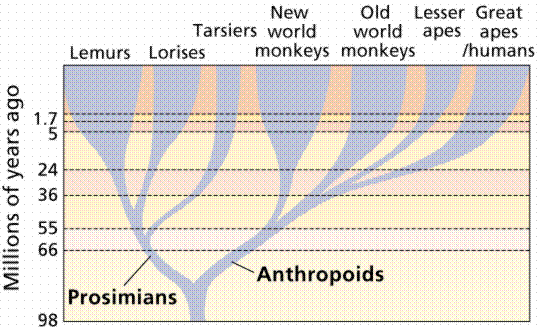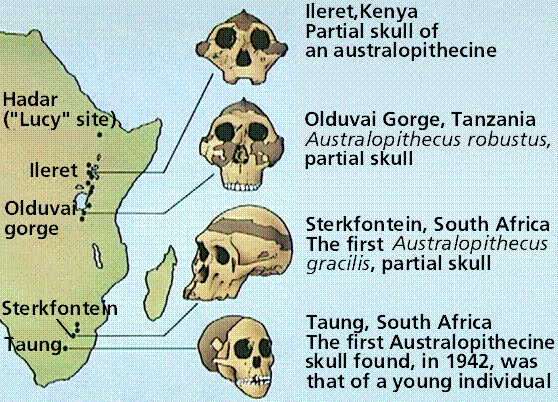Primates and Their Adaptations | Origin of Apes and Hominids | The Neandertals
Agriculture and Migrations | Links
Mammals developed from primitive mammal-like reptiles during the Triassic Period, some 200-245 million years ago. After the terminal Cretaceous extinction (65 million years ago) eliminated the dinosaurs, mammals as one of the surviving groups, underwent an adaptive radiation during the Tertiary Period. The major orders of mammals developed at this time, including the Primates to which humans belong.

The above image is modified from http://www.whfreeman.com/life/update/.
Other primates include the tarsiers, lemurs, gibbons, monkeys, and apes. Although we have significant differences from other primates, we share an evolutionary history that includes traits such as opposable thumbs, stereoscopic vision, larger brains, and nails replacing claws.
Primates are relatively unspecialized mammals: they have no wings, still have all four limbs, cannot run very fast, have generally weak teeth, and lack armor or thick protective hides. However, the combination of primate adaptations that include larger brains, tool use, social structure, stereoscopic color vision, highly developed forelimbs and hands, versatile teeth, and upright posture, place them among the most advanced mammals (at least as judged from an anthrocentric perspective!).
Approximately 20 million years ago central and east Africa was densely forested. Climatic changes resulting from plate tectonic movements and episodes of global cooling about 15 million years ago caused a replacement of the forest by a drier-adapted savanna mixed with open areas of forest. During the course of hominid evolution, periodic climate changes would trigger bursts of evolution and/or extinction.
Primates have modifications to their ulna and radius (bones of the lower arm) allowing them to turn their hand without needing to turn their elbow. Many primates can also swivel or turn their arms at the shoulder. These two adaptations offer advantages to life in the trees.
Primates have five digits on their forelimbs. They are able to grasp objects with their forelimbs in what is known as a prehensile movement. A second modification makes one of the digits opposable, allowing the tips of the fingers and thumb to touch.
Placement of the eyes on the front of the head increases depth perception, an advantageous trait in tree-dwelling primates. Changes in the location of rods and cones in the eye adapted primates for color vision as well as peripheral vision in dim light.
Upright posture allows a primate to view its surroundings as well as to use its hands for some other task. Hominids, the lineage leading to humans, had changes in the shape and size of their pelvis, femur, and knees that allowed bipedalism (walking on two legs). The change from quadruped to biped happened in stages, culminating in humans, who can walk or run on two legs.
Several trends of primate evolution are evident in the teeth and jaw. First, change in the geometry of the jaw reduced the snout into a flat face. Second, changes in tooth arrangement and numbers increased the efficiency of those teeth for grinding food. Third, about 1.5 million years ago our diet changed from fruits and vegetables to include meat.
The fossil record indicates primates evolved about approximately 30 million years ago in Africa. One branch of primates evolved into the Old and New World Monkeys, the other into the hominoids (the line of descent common to both apes and man). Fossil hominoids occur in Africa during the Miocene epoch of the Tertiary period. They gave rise to an array of species in response to major climate fluxes in their habitats. However, the nature of those habitats leads to an obscuration of the line that leads to humans (the hominids).
Until a few years ago, the ramapiths were thought to have given rise to the hominids. We now consider ramapiths ancestral to the orangutang. The hominid line arose from some as-yet-unknown ancestor. Lacking fossil evidence, biochemical and DNA evidence suggests a split of the hominid from hominoid line about 6 to 8 million years ago.

The above image is modified from http://www.whfreeman.com/life/update/.
Australopithecus afarensis, the first of the human-like hominids we know of, first appeared about 3.6-4 million years ago. This species had a combination of human (bipedalism) and apelike features (short legs and relatively long arms). The arm bones were curved like chimps, but the elbows were more human-like. Scientists speculate that A. afarensis spent some time climbing trees, as well as on the ground.
Australopithecus ramidus is an older species, about 4.4 million years, and is generally considered more anatomically primitive than A. afarensis. The relationship between the two species remains to be solved.
The role of A. afarensis as the stem from which the other hominids arose is in some dispute. About 2 million years ago, after a long million year period of little change, as many as six hominid species evolved in response to climate changes associated with the beginning of the Ice Age. Two groups developed: the australopithecines, generally smaller brained and not users of tools; and the line that led to genus Homo, larger brained and makers and users of tools. The australopithecines died out 1 million years ago; Homo, despite their best efforts (atomic weapons, pollution) are still here!
With an incomplete fossil record, australopithecines, at least the smaller form, A. africanus, was thought ancestral to Homo. Recent discoveries, however have caused a reevaluation of that hypothesis. One pattern is sure, human traits evolved at different rates and at different times, in a mosaic: some features (skeletal, dietary) establishing themselves quickly, others developing later (toolmaking, language, use of fire).
A cluster of species developed about 2-2.5 million years ago in Africa. Homo had a larger brain and a differently shaped skull and teeth than the australopithecines. About 1.8 million years ago, early Homo gave rise to Homo erectus, the species thought to have been ancestral to our own.
Soon after its origin (1.8 million but probably older than 2 million years ago) in Africa, Homo erectus appears to have migrated out of Africa and into Europe and Asia. Homo erectus differed from early species of Homo in having a larger brain size, flatter face, and prominent brow ridges. Homo erectus is similar to modern humans in size, but has some differences in the shape of the skull, a receding chin, brow ridges, and differences in teeth. Homo erectus was the first hominid to:
Between 100,000 and 500,000 years ago, the world population of an estimated 1 million Homo erectus disappeared, replaced by a new species, Homo sapiens. How, when and where this new species arose and how it replaced its predecessor remain in doubt. Answering those questions has become a multidisciplinary task.
Two hypotheses differ on how and where Homo sapiens originated.
Which hypothesis is correct? Scientists can often use the same "evidence" to support contrasting hypotheses depending on which evidence (fossils or molecular clock/DNA studies) one gives more weight to. The accuracy of the molecular clock, so key to the out-of-Africa hypothesis, has recently been questioned. Recent studies on the Y-chromosome seem to weaken the regional continuity hypothesis by indicating a single point-of-origin for our species some 270,000 years ago. Continued study will no doubt reveal new evidence and undoubtedly new hypotheses will arise. It is a task for all of us to weigh the evidence critically and reach a supportable conclusion, whether we are scientists or not.
Archaic H. sapiens lived from 500,000 to 30,000 years ago and combined features of H. sapiens with those of H. erectus. The Neandertals, considered in this group, lived in Europe and western Asia between 100,000 and 30,000 years ago before their disappearance. Neandertals were larger-brained than modern humans, had a sloping forehead, prominent brow ridges and a receding chin. They had a very prominent nose and ranged in height from 5 foot 2 inches (average female) to 5 foot 6 inches (average male).
Despite their image as brutish simpletons, Neandertals were the first humans to bury their dead with artifacts, indicating abstract thought, perhaps a belief in an after-life. They lived in free-standing settlements, as well as caves. Neandertal tools were more sophisticated than H. erectus' tools, employing handles to gain extra leverage.
Did Neandertals evolve gradually into modern humans, or were they replaced by modern forms originating from a single population? The answer to that depends on the answer to the question of the origin of H. sapiens from H. erectus. The out-of-Africa hypothesis suggests Neandertals were a separate species (H. neandertalensis) replaced as modern humans (H. sapiens) spread from Africa. The regional continuity hypothesis suggests Neandertals were a subspecies (H. sapiens neandertalensis) that evolved into modern humans (H. sapiens sapiens).
Since the evolution of H. erectus, migrations have been a fact of human existence, helping to spread genetic diversity as well as technological innovation. The most recent innovations have not been physical, but rather cultural.
The Neolithic transition, about 10,000 years ago, involved the change from hunter-gatherer societies to agricultural ones based on cultivation of plants and domesticated animals. Evidence suggests this began in the Middle East and spread outward via migrations.
Genetic studies suggest agriculture spread by the migration of farmers into hunter-gatherer societies. This would produce a genetic blurring as the farmers interbred with the indigenous peoples, a pattern supported by genetics.
Most anthropologists agree that the New World was populated by a series of three migrations over the temporary land connection between Asia and North America. The immigrants spread southward, eventually reaching Tierra del Fuego in the southernmost part of South America.
Mitochondrial DNA studies find four distinct groups descended from peoples of Siberia. Amerind mtDNA suggests two waves of migration (one perhaps as old as 21-42 thousand years ago). The genetic model confirms the accepted ideas about human migration into the Americas and suggests a possible fourth wave.
Email: mj.farabee@emcmail.maricopa.edu![]()
Last modified: 2000/01/07:12:40:30
The URL of this page is: gened.emc.maricopa.edu/bio/BIO181/BIOBK/BioBookHumEvol.html